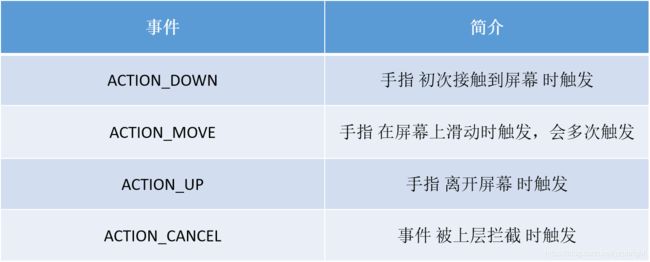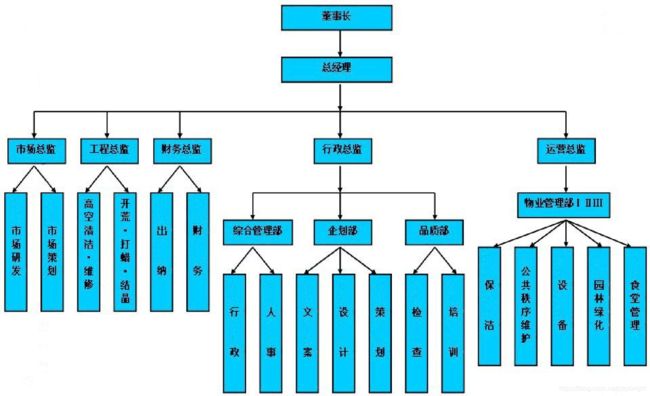Android高级UI之View事件分发机制与事件冲突的原因及解决
onTouch与onClick之间会产生事件冲突吗?
事件在控件中时如何传递的?
事件冲突的根本原因?
如何解决事件冲突?
MotionEvent
View继承关系
ViewGroup,先要走分发事件流程,再走处理事件流程
View,只能走处理事件流程
onTouch与onClick之间会产生事件冲突吗?
//View.java
/**
* Pass the touch screen motion event down to the target view, or this
* view if it is the target.
*
* @param event The motion event to be dispatched.
* @return True if the event was handled by the view, false otherwise.
*/
public boolean dispatchTouchEvent(MotionEvent event) {
...
//noinspection SimplifiableIfStatement
ListenerInfo li = mListenerInfo;
if (li != null && li.mOnTouchListener != null
&& (mViewFlags & ENABLED_MASK) == ENABLED
&& li.mOnTouchListener.onTouch(this, event)) {
result = true;
}
if (!result && onTouchEvent(event)) {
result = true;
}
...
}
View的dispatchTouchEvent方法先执行mOnTouchListener的onTouch()方法,只有onTouch()方法返回false时,才去执行onTouchEvent()方法,onClick()方法是在onTouchEvent()方法中调用的。
所以只要onTouch()方法返回true,则onClick()方法是不会执行的。
ViewGroup的dispatchTouchEvent()
//ViewGroup.java
@Override
public boolean dispatchTouchEvent(MotionEvent ev) {
if (mInputEventConsistencyVerifier != null) {
mInputEventConsistencyVerifier.onTouchEvent(ev, 1);
}
// If the event targets the accessibility focused view and this is it, start
// normal event dispatch. Maybe a descendant is what will handle the click.
if (ev.isTargetAccessibilityFocus() && isAccessibilityFocusedViewOrHost()) {
ev.setTargetAccessibilityFocus(false);
}
boolean handled = false;
if (onFilterTouchEventForSecurity(ev)) {
final int action = ev.getAction();
final int actionMasked = action & MotionEvent.ACTION_MASK;
// Handle an initial down.
if (actionMasked == MotionEvent.ACTION_DOWN) {
// Throw away all previous state when starting a new touch gesture.
// The framework may have dropped the up or cancel event for the previous gesture
// due to an app switch, ANR, or some other state change.
cancelAndClearTouchTargets(ev);
resetTouchState();
}
// 步骤1:检查是否要拦截事件,注意是在ACTION_DOWN事件进行判断的
// Check for interception.
final boolean intercepted;
if (actionMasked == MotionEvent.ACTION_DOWN
|| mFirstTouchTarget != null) {
//如果是ACTION_DOWN事件或者已经有targets要消费该事件,则进行判断是否要拦截事件
final boolean disallowIntercept = (mGroupFlags & FLAG_DISALLOW_INTERCEPT) != 0;
if (!disallowIntercept) {
//只有disallowIntercept为false,才会调用onInterceptTouchEvent()判断是否拦截
intercepted = onInterceptTouchEvent(ev);
ev.setAction(action); // restore action in case it was changed
} else {
intercepted = false;
}
} else {
// 如果不是ACTION_DOWN事件,并且也没有targets要消费该事件,则ViewGroup进行拦截,自己处理该事件
// There are no touch targets and this action is not an initial down
// so this view group continues to intercept touches.
intercepted = true;
}
// 如果要拦截该事件,则下面的步骤2是不会执行的,直接执行步骤3进行事件分发
// If intercepted, start normal event dispatch. Also if there is already
// a view that is handling the gesture, do normal event dispatch.
if (intercepted || mFirstTouchTarget != null) {
ev.setTargetAccessibilityFocus(false);
}
// Check for cancelation.
final boolean canceled = resetCancelNextUpFlag(this)
|| actionMasked == MotionEvent.ACTION_CANCEL;
// Update list of touch targets for pointer down, if needed.
final boolean split = (mGroupFlags & FLAG_SPLIT_MOTION_EVENTS) != 0;
TouchTarget newTouchTarget = null;
boolean alreadyDispatchedToNewTouchTarget = false;
//步骤2:如果不拦截事件,则进行寻找targets来消费该事件
if (!canceled && !intercepted) {
//如果不拦截,
// If the event is targeting accessibility focus we give it to the
// view that has accessibility focus and if it does not handle it
// we clear the flag and dispatch the event to all children as usual.
// We are looking up the accessibility focused host to avoid keeping
// state since these events are very rare.
View childWithAccessibilityFocus = ev.isTargetAccessibilityFocus()
? findChildWithAccessibilityFocus() : null;
//只有对DOWN事件才会分发,MOVE和UP事件不会分发
if (actionMasked == MotionEvent.ACTION_DOWN
|| (split && actionMasked == MotionEvent.ACTION_POINTER_DOWN)
|| actionMasked == MotionEvent.ACTION_HOVER_MOVE) {
final int actionIndex = ev.getActionIndex(); // always 0 for down
final int idBitsToAssign = split ? 1 << ev.getPointerId(actionIndex)
: TouchTarget.ALL_POINTER_IDS;
// Clean up earlier touch targets for this pointer id in case they
// have become out of sync.
removePointersFromTouchTargets(idBitsToAssign);
final int childrenCount = mChildrenCount;//ViewGroup的直接子View的数量
if (newTouchTarget == null && childrenCount != 0) {
final float x = ev.getX(actionIndex);
final float y = ev.getY(actionIndex);
// Find a child that can receive the event.
// Scan children from front to back.
final ArrayList<View> preorderedList = buildTouchDispatchChildList();//对直接子View按照Z轴进行排序
final boolean customOrder = preorderedList == null
&& isChildrenDrawingOrderEnabled();
final View[] children = mChildren;
for (int i = childrenCount - 1; i >= 0; i--) {
final int childIndex = getAndVerifyPreorderedIndex(
childrenCount, i, customOrder);
final View child = getAndVerifyPreorderedView(
preorderedList, children, childIndex);
// If there is a view that has accessibility focus we want it
// to get the event first and if not handled we will perform a
// normal dispatch. We may do a double iteration but this is
// safer given the timeframe.
if (childWithAccessibilityFocus != null) {
if (childWithAccessibilityFocus != child) {
continue;
}
childWithAccessibilityFocus = null;
i = childrenCount - 1;
}
//判断这个child是否能接收事件,并且点击事件在child范围里面
if (!canViewReceivePointerEvents(child)
|| !isTransformedTouchPointInView(x, y, child, null)) {
ev.setTargetAccessibilityFocus(false);
continue;
}
//走到这里,说明这个child能接收事件,并且点击事件在child范围里面
newTouchTarget = getTouchTarget(child);
if (newTouchTarget != null) {
// Child is already receiving touch within its bounds.
// Give it the new pointer in addition to the ones it is handling.
newTouchTarget.pointerIdBits |= idBitsToAssign;
break;
}
resetCancelNextUpFlag(child);
//调用dispatchTransformedTouchEvent()方法将事件分发给child,dispatchTransformedTouchEvent()返回true表示child处理了该事件
if (dispatchTransformedTouchEvent(ev, false, child, idBitsToAssign)) {
// 进入到这里表示child处理了该事件
// Child wants to receive touch within its bounds.
mLastTouchDownTime = ev.getDownTime();
if (preorderedList != null) {
// childIndex points into presorted list, find original index
for (int j = 0; j < childrenCount; j++) {
if (children[childIndex] == mChildren[j]) {
mLastTouchDownIndex = j;
break;
}
}
} else {
mLastTouchDownIndex = childIndex;
}
mLastTouchDownX = ev.getX();
mLastTouchDownY = ev.getY();
//调用addTouchTarget()为该child创建一个新的TouchTarget插入到mFirstTouchTarget指向的链表的前面(头插法)
newTouchTarget = addTouchTarget(child, idBitsToAssign);
alreadyDispatchedToNewTouchTarget = true;
break;
}
// The accessibility focus didn't handle the event, so clear
// the flag and do a normal dispatch to all children.
ev.setTargetAccessibilityFocus(false);
}
if (preorderedList != null) preorderedList.clear();
}
if (newTouchTarget == null && mFirstTouchTarget != null) {
// Did not find a child to receive the event.
// Assign the pointer to the least recently added target.
newTouchTarget = mFirstTouchTarget;
while (newTouchTarget.next != null) {
newTouchTarget = newTouchTarget.next;
}
newTouchTarget.pointerIdBits |= idBitsToAssign;
}
}
}
//步骤3:事件分发流程(normal event dispatch),进行事件的分发和处理。拦截或者不拦截事件都会走到这里
// Dispatch to touch targets.
if (mFirstTouchTarget == null) {
//两种情况会走到这里:1.如果自己不拦截事件但是没子View领取事件, 2.或者自己要拦截该事件
// child参数传null,表示自己处理该事件
// No touch targets so treat this as an ordinary view.
handled = dispatchTransformedTouchEvent(ev, canceled, null,
TouchTarget.ALL_POINTER_IDS);
} else {
//如果自己不拦截事件并且子View处理了该事件会走到这里
// Dispatch to touch targets, excluding the new touch target if we already
// dispatched to it. Cancel touch targets if necessary.
TouchTarget predecessor = null;
TouchTarget target = mFirstTouchTarget;
while (target != null) {
//while循环解决多点触控
final TouchTarget next = target.next;
//DOWN事件分发会走这里
//如果alreadyDispatchedToNewTouchTarget=true并且target == newTouchTarget表示上面child已经处理过了
if (alreadyDispatchedToNewTouchTarget && target == newTouchTarget) {
handled = true;
} else {
final boolean cancelChild = resetCancelNextUpFlag(target.child)
|| intercepted;
//MOVE事件分发会走这里
if (dispatchTransformedTouchEvent(ev, cancelChild,
target.child, target.pointerIdBits)) {
handled = true;
}
if (cancelChild) {
if (predecessor == null) {
mFirstTouchTarget = next;
} else {
predecessor.next = next;
}
target.recycle();
target = next;
continue;
}
}
predecessor = target;
target = next;
}
}
// Update list of touch targets for pointer up or cancel, if needed.
if (canceled
|| actionMasked == MotionEvent.ACTION_UP
|| actionMasked == MotionEvent.ACTION_HOVER_MOVE) {
resetTouchState();
} else if (split && actionMasked == MotionEvent.ACTION_POINTER_UP) {
final int actionIndex = ev.getActionIndex();
final int idBitsToRemove = 1 << ev.getPointerId(actionIndex);
removePointersFromTouchTargets(idBitsToRemove);
}
}
if (!handled && mInputEventConsistencyVerifier != null) {
mInputEventConsistencyVerifier.onUnhandledEvent(ev, 1);
}
return handled;
}
/**
* 调用该方法的结果是:要么ViewGroup自己处理了事件,要么child递归进行上述分析的dispatchTouchEvent()流程
*
* Transforms a motion event into the coordinate space of a particular child view,
* filters out irrelevant pointer ids, and overrides its action if necessary.
* If child is null, assumes the MotionEvent will be sent to this ViewGroup instead.
*/
private boolean dispatchTransformedTouchEvent(MotionEvent event, boolean cancel,
View child, int desiredPointerIdBits) {
final boolean handled;
// Canceling motions is a special case. We don't need to perform any transformations
// or filtering. The important part is the action, not the contents.
final int oldAction = event.getAction();
if (cancel || oldAction == MotionEvent.ACTION_CANCEL) {
event.setAction(MotionEvent.ACTION_CANCEL);
if (child == null) {
handled = super.dispatchTouchEvent(event);
} else {
handled = child.dispatchTouchEvent(event);//分发一个cancel事件给child
}
event.setAction(oldAction);
return handled;
}
// Calculate the number of pointers to deliver.
final int oldPointerIdBits = event.getPointerIdBits();
final int newPointerIdBits = oldPointerIdBits & desiredPointerIdBits;
// If for some reason we ended up in an inconsistent state where it looks like we
// might produce a motion event with no pointers in it, then drop the event.
if (newPointerIdBits == 0) {
return false;
}
// If the number of pointers is the same and we don't need to perform any fancy
// irreversible transformations, then we can reuse the motion event for this
// dispatch as long as we are careful to revert any changes we make.
// Otherwise we need to make a copy.
final MotionEvent transformedEvent;
if (newPointerIdBits == oldPointerIdBits) {
if (child == null || child.hasIdentityMatrix()) {
if (child == null) {
handled = super.dispatchTouchEvent(event);
} else {
final float offsetX = mScrollX - child.mLeft;
final float offsetY = mScrollY - child.mTop;
event.offsetLocation(offsetX, offsetY);
handled = child.dispatchTouchEvent(event);
event.offsetLocation(-offsetX, -offsetY);
}
return handled;
}
transformedEvent = MotionEvent.obtain(event);
} else {
transformedEvent = event.split(newPointerIdBits);
}
// Perform any necessary transformations and dispatch.
if (child == null) {
//如果child==null,则调用super.dispatchTouchEvent()进行处理事件,即调用View的dispatchTouchEvent()
handled = super.dispatchTouchEvent(transformedEvent);
} else {
final float offsetX = mScrollX - child.mLeft;
final float offsetY = mScrollY - child.mTop;
transformedEvent.offsetLocation(offsetX, offsetY);
if (! child.hasIdentityMatrix()) {
transformedEvent.transform(child.getInverseMatrix());
}
handled = child.dispatchTouchEvent(transformedEvent);
}
// Done.
transformedEvent.recycle();
return handled;
}
/**
* Adds a touch target for specified child to the beginning of the list.
* Assumes the target child is not already present.
*/
private TouchTarget addTouchTarget(@NonNull View child, int pointerIdBits) {
final TouchTarget target = TouchTarget.obtain(child, pointerIdBits);
target.next = mFirstTouchTarget;
mFirstTouchTarget = target;
return target;
}
/**
* 判断一个View能否接收事件,满足两个条件中的一个:
* 1.View是VISIBLE的
* 2.如果View不是VISIBLE,但是有动画
*
* Returns true if a child view can receive pointer events.
* @hide
*/
private static boolean canViewReceivePointerEvents(@NonNull View child) {
return (child.mViewFlags & VISIBILITY_MASK) == VISIBLE
|| child.getAnimation() != null;
}
/**
* 判断点击事件是否在child里面
*
* Returns true if a child view contains the specified point when transformed
* into its coordinate space.
* Child must not be null.
* @hide
*/
protected boolean isTransformedTouchPointInView(float x, float y, View child,
PointF outLocalPoint) {
final float[] point = getTempPoint();
point[0] = x;
point[1] = y;
transformPointToViewLocal(point, child);
final boolean isInView = child.pointInView(point[0], point[1]);
if (isInView && outLocalPoint != null) {
outLocalPoint.set(point[0], point[1]);
}
return isInView;
}
总结
一、
ViewGroup,先要走分发事件流程,如果没人处理事件,就再走处理事件流程
View,只能走处理事件流程
二、
分发流程:
DOWN–确定事件给谁
1.先判断是否拦截后自己处理事件(即不分发下去)
2.如果不拦截,则分发下去:
排序
遍历分发
领取事件的子View 处理事件
3.如果没子View领取或者自己要拦截该事件,再看下自己是否要处理该事件,进行事件分发处理流程
(如果自己要拦截该事件,则相当于自己是最后一个View,要判断自己是否要处理该事件
)
MOVE–处理事件
1.先看是否拦截后自己处理事件(即不分发下去),子View可以请求不拦截
2.分发下去:
直接由down事件确定的view进行事件处理
拦截MOVE事件—只能在MOVE事件中处理事件冲突
如果之前已经将事件分发给了子View,但是后来父容器拦截了MOVE事件,则
第一个MOVE事件的作用:给子View发送一个cancel事件,并且将mFirstTouchTarget置为null(对于单点触摸事件),这时候父容器是没有处理这个MOVE事件的。
第二个MOVE事件到来时,父容器才处理事件。
三、
对于叶节点,如果没有拿到DOWN事件,则也就拿不到MOVE和UP事件;但是对于非叶节点,如果没有拿到DOWN事件,也可以拿到MOVE和UP事件。
四、
对于ACTION_MOVE和ACTION_UP事件,因为mFirstTouchTarget != null,所以也会调用onInterceptTouchEvent()判断是否要拦截:
@Override
public boolean dispatchTouchEvent(MotionEvent ev) {
...
// Check for interception.
final boolean intercepted;
if (actionMasked == MotionEvent.ACTION_DOWN
|| mFirstTouchTarget != null) {
final boolean disallowIntercept = (mGroupFlags & FLAG_DISALLOW_INTERCEPT) != 0;
if (!disallowIntercept) {
intercepted = onInterceptTouchEvent(ev);
ev.setAction(action); // restore action in case it was changed
} else {
intercepted = false;
}
} else {
// There are no touch targets and this action is not an initial down
// so this view group continues to intercept touches.
intercepted = true;
}
...
}
五、
只有ACTION_DOWN事件才会从直接子View中寻找TouchTarget,寻找到新的TouchTarget时会更新mFirstTouchTarget,所以只要找到TouchTarget那么mFirstTouchTarget就!=null,如果没有从子View中找到TouchTarget或者自己拦截了事件,则TouchTarget==null。ACTION_MOVE事件不会寻找TouchTarget。
六、
当子View作为TouchTarget,但是后面的MOVE事件父容器进行了拦截,则第一个MOVE事件会转为CANCEL事件分发给TouchTarget。
七、
子View一旦拿到DOWN事件,后面的事件由谁处理是由子View决定的。
八、
父布局可以拦截子布局的事件,但是子布局不能拦截父布局的事件。



